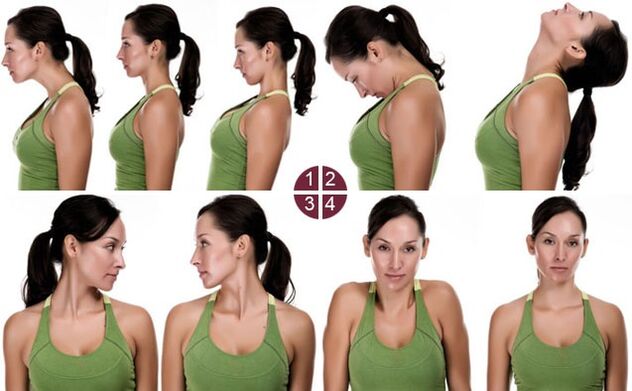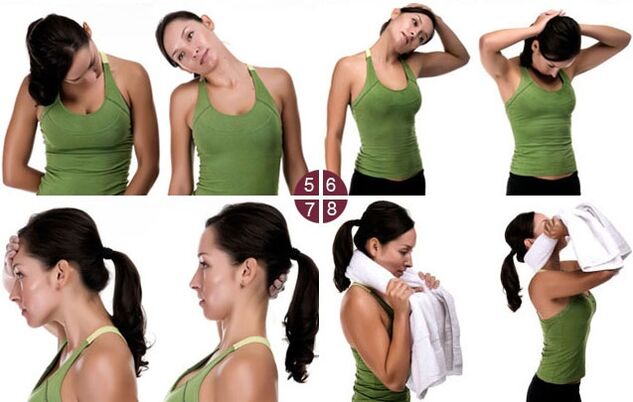
Osteochondrosis of the cervical spine is an insidious disease. The age threshold of incidence falls every year, so now the problem of treating cervical osteochondrosis is as acute as ever.
People who lead a sedentary and passive lifestyle eventually realize that osteochondrosis has come to them silently.
The causes of osteochondrosis are the inactivity of the back and neck muscles, due to which they weaken. Spinal discs left without muscular support are overloaded.
A constantly sedentary lifestyle, wrong posture lead to deformation of the vertebral discs. Deformed vertebral discs compress nerve endings. As a result, a person feels pain in the back, cervical spine.
How to treat cervical osteochondrosis and prevent its occurrence? Doctors recommend special exercises that strengthen the muscles and tendons of the cervical, back and shoulder girdle. This is the safest way to treat osteochondrosis.
The benefits of exercise
As mentioned above, the causes of osteochondrosis are a sedentary lifestyle, weakening of the muscular core and curvature of the spine. In the initial stages of the disease, exercise will stop its further development. Due to regular physical activity, blood circulation improves, the muscles of the spine and the cervical region are toned, the load on the back decreases, the distance between the vertebral discs increases, the friction between the vertebral discs decreases and, accordingly, the frequency ofpain decreases.


And if the disease has developed to the point where severe frequent pain is felt, it is necessary to consult a specialist. He will make an accurate diagnosis, the degree of the disease, prescribe a course of treatment, massage. After completing the treatment course, therapeutic exercises will be prescribed, which you can do yourself at home. Such treatment of cervical osteochondrosis at home will allow you to quickly forget about the disease.
Exercises must be chosen correctly and performed in doses. Otherwise, there is a risk of worsening your health.
Useful tips
Before you start exercising, you should read the useful tips.
- A set of exercises should be performed regularly, regardless of the location: study, work, home, etc. Initially, to accelerate progress, you should do the exercises every day. And in the future, when the condition improves, you can practice 2-3 days a week to maintain the result;
- If you feel pain or swelling, this is a signal that it is time to move a little. In this case, you need to get up, walk around, lie down, perform exercises against osteochondrosis. You can take a little walk;
- You must constantly complicate the lesson. You can add other exercises to the complex or increase the number of repetitions;
- Exercising regularly is, of course, good, but don't forget about your feelings. If during the lessons you feel severe pain in the cervical region, you should stop the classes;
- To increase the effectiveness of the treatment, you can have a massage and take a contrast shower more often. These procedures contribute to additional muscle relaxation;
- Exercises should be performed while maintaining an upright posture and pay attention to execution technique. At first it will be a little difficult, but thanks to the correct execution, the muscles will be strengthened and it will be easier to practice.
A set of exercises (warm-up)
Before you start exercising, be sure to start with a warm-up:
- You need to stand straight, spread your legs shoulder-width apart, take a deep breath and exhale several times. After that, you need to perform regular animations to the right, left, forward, back. Leaning back should be done carefully, without causing pain. If bending the back causes pain, then you can refuse to perform them.
- The next warm-up is turning the head right and left to the limit. Despite its simplicity, this exercise can cause difficulties for those people, the cervical spine does not allow turning the head all the way in one direction or another. In such cases, turning the head is not worth causing pain. The exercise should be performed smoothly, without sudden movements.
- Finally, stand up straight, pull your shoulders back, bring your shoulder blades together, stick your chest out. Then reduce the shoulder joints, round the back. The exercise should be done slowly, smoothly, under inhalation and exhalation.
Types of exercises
This gymnastics, consisting of a group of exercises, is not difficult. You can perform them at home, standing or sitting. The most important thing is to keep your spine straight and relax your shoulders. But it is preferable to perform them standing, since in this position the spine is straightened as much as possible.
Gymnastics number 1
Pressure on the hands with the head forward. The hands should be clasped in the lock and placed on the forehead. The hands held in the lock press back into the head, and the head should resist and press forward into the hands. The neck should be tightened. You should stay in this position for 15-20 seconds. Then place one hand on the back of your neck and tilt your head back. At the same time, the working muscles of the neck are stretched. This exercise is useful for strengthening the neck muscles, which allows you to weaken cervical osteochondrosis.
Gymnastics number 2
Hand pressure on the back of the head. In this exercise, you need to tie your hands in a lock and place them in this form on the back of your head. Then apply pressure to the back of the head with your hands and the head should resist the hands. Duration - 15 - 20 seconds. In this case, the muscles of the cervical spine are tense. This exercise can be combined with the first for a harmonious workout.
Gymnastics number 3
The head tilts to the side. In this exercise, place your right (left) palm on your ear. You should try to reach the right (left) shoulder with your head and resist with your working hand. In this position, you should stay for 15-20 seconds. Then do the same with the other side.
Gymnastics number 4
Turning his head to the side. In this exercise, you need to turn your head to the sides. To do this, place the right (left) palm on the right (left) cheek. Turn the head to the right (left) and the working hand resists. In each position, you need to stay for 15 - 20 seconds.
Gymnastics number 5
Stretching the neck with hands. Doing this exercise may be difficult at first, but with time you can get used to it. Place your thumbs on your lower jaw and cover the back of your head with the rest of your fingers. In this position, pull your head up, you can perform rocking movements. That is, to simulate an attempt to remove the cork from the bottle. You can't turn your head, she has to look straight ahead. The duration of the exercise is 15 - 20 seconds. The exercise should be repeated several times.
Gymnastics number 6
Stand straight and stretch your arms out to the sides. Hands should be relaxed. Make rotations of the right and left shoulder joint alternately, then simultaneously. The body should be bent forward. It is necessary to perform the exercise for each shoulder for 1 minute. This exercise is recommended for those who feel tension in the shoulder area.
Gymnastics №7
Spinning of the head. In this exercise, you should turn your head to the right (left) shoulder and tighten your neck. Perform a rotation of the head on both sides. At the end of the repetition, the head should turn to the other shoulder. Try to pull your shoulders back. Perform the exercise carefully, head movement must be controlled throughout the exercise. In case of discomfort, you can simply turn your head to the side. The exercise should be repeated 10-12 times.
This is the whole complex of exercises aimed at preventing osteochondrosis of the cervical spine. It is not necessary to perform all exercises, you can choose only those that do not bring discomfort and pain. Office workers are advised to sit while working. In addition, you can perform hanging on the horizontal bar in the morning. This will lengthen the spine, give the body energy. Swimming, figure skating, dancing, gymnastics also help prevent osteochondrosis and accelerate the treatment process. If the classes are regular, and the person himself becomes more mobile, then you can get rid of pain in the muscles and bones of the cervical region.













































